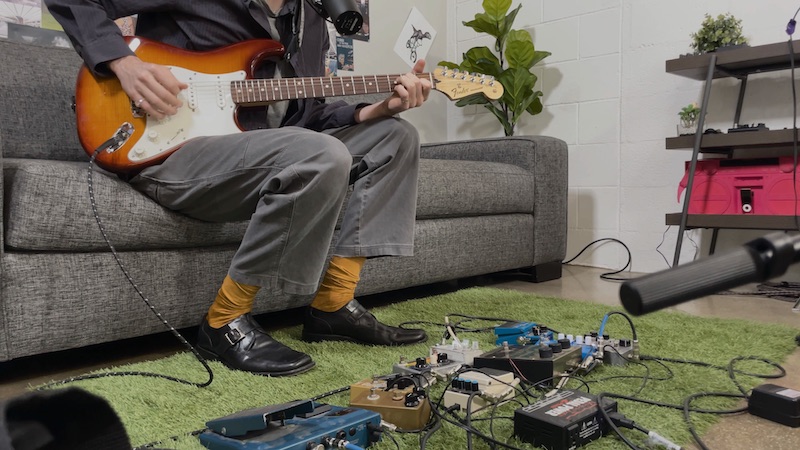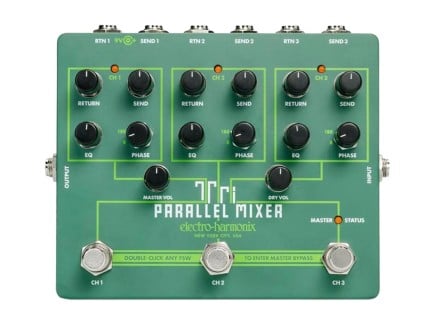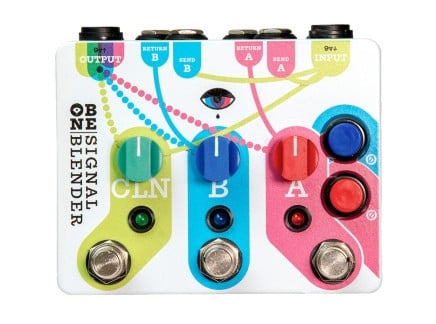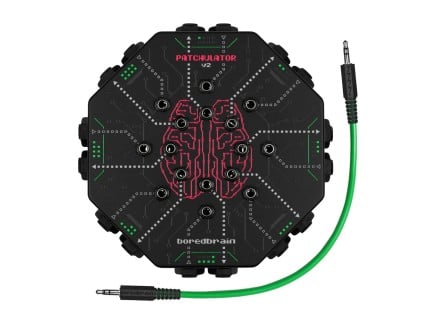When approached with an open mind, effect processing can take on a tremendously significant role in the creative process. Sure, processing is a great way of making cool sounds—but when treated with an adventurous spirit, it can become a source of sonic inspiration all their own, turning familiar instruments and sounds into something that shifts in character and response as you play. Audio effects turn the familiar into something unfamiliar, revitalizing even the most mundane sounds, and inspiring you to approach your instrument in a new way. This approach to effect processing is a cornerstone of countless musical genres...and at the nexus of several of them, you'll find musician Dylan Moon.
Luckily, Dylan came by our studio recently to hang out, talk about pedals, and show us exactly how some creative tinkering with effect processing can lead to truly inspiring, unexpected sounds. Check out the video above, and read on for more info about Dylan and our takeaways from his visit.
Who is Dylan Moon?
I only became aware of Dylan's music quite recently, and have been playing his first album Only the Blues (RVNG, 2019) and EP Oh No Oh No Oh No (RVNG, 2020) nonstop ever since. In his music, Elliott Smith-like songwriting and delivery fuse with dusty, late '80s dream pop backing rhythms and shoegaze-like ambient background textures. I personally love all of those elements in isolation—but fusing them in the exact way that Moon does feels instantly compelling, familiar, and emotionally rich. If you're at all into '80s and '90s indie/alt rock, you'll find Moon's music to be nostalgic, inventive, and at the right moments, cathartic.
The similarity to shoegaze is notable, to say the least: it seems that experimenting with a variety of processing techniques to create contrasting sonic textures is a big part of Moon's M.O. But while classic shoegaze is often about creating a bombastic wall of distorted sound, Moon embraces this sonic extreme as only one option of many: sure, there are bombastic sounds in his music, but they're saved for moments of particular intensity. Instead of lingering in these enormous, brash textures, he drifts between a huge range of sonic spaces. Some are small, some large, some swelling and shifting in shape—some are calm and drifting, while others are sedate and detached, and yet others are bursting with frantic energy.
Listening to his music, it becomes clear that Moon is quite a proficient musician and recording engineer; and in fact, he did study production and sound design in college, ultimately settling in Los Angeles in order to find work in the film industry. Having worked on all manner of music from pop to prog and electronic beat-making, he seems to have found a sweet spot in the world of songwriting...and frankly, I'm quite interested to hear what he'll get up to next. Happily, it won't be a long wait: his next album Option Explore is being released by RVNG on June 17th of this year.
Dylan's Setup: Parallel Processing All Over the Dang Place
Moon's setup for the video above is worth a bit of dissection, in that I think it clearly demonstrates a number of super interesting, creative ideas about music-making altogether. Let's first take a look at what's in his setup for the video and how it's all connected, and then discuss some interesting takeaways from the way he's assembled this setup. I'll say before we get started...a lot of what's interesting here has to do with his approach to signal routing. Rather than plugging his guitar into a single pedal and following a straight path through all the others into an amp, his signal paths diverge and converge in several directions, winding up in completely different amps by the end of things. Check it out.

Dylan's signal chain starts with a Saturnworks dual (parallel) effect loop pedal, which sends his signal down two completely different paths. The first effect loop is fairly simple: it's an Analogman Fuzz Face clone running into a Catalinbread Echorec echo pedal.
The second loop is a bit more complex. It starts with a Boss DD-6 Digital Delay...but he's not using it for delay: instead, he's using it as a buffered signal splitter, sending his signal down two further paths. The first output from the DD-6 passes to an Electro-Harmonix Electric Mistress flanger, then to a Montreal Assembly Count to 5 (a peculiar sampler/pitch shifter/granular effect that we simply adore). From there, it goes into a Fairfield Circuitry Meet Maude, which most folks use as a delay: however, he's simply using it as a way to darken up/add a general lo-fi quality to his sounds before the final step in this loop, a Boss BD-2 Blues Driver. The mixed output of the Saturnworks effect loop pedal passes through a Mid-Fi Electronics Magick "i" overdrive, taking these two distinct signal paths and gluing them together with just the right amount of dirt and the type of compression that naturally comes along with distortion-based processes. From there, his sound travels to a Fender Super Reverb (an excellent amp for heavy effect pedal use).
And that brings us back to that cleverly-misused Boss DD-6. While one of its outputs continues through the aforementioned string of effects and back into the Saturnworks effect loop pedal, the other output continues onward toward a Digitech XP-300 Space Station (or, well, a modified XP-200 with the Space Station effect programs loaded)...making for all sorts of peculiar, spacey, otherworldly sonic textures. The signal passes from the Space Station on to a Sears catalog Silvertone amp: a cult classic small amp that provides a pleasant distorted crunch to basically anything you run through it. This is a particularly interesting approach: the Space Station, usually praised for its bizarre flavor of 1990s clean digital tone, takes on a significantly different character when forced through a small, distortion-ridden amp: turning its blissful huge textures into something that feels much more corroded, degraded, and distant. It sound really cool. Not to mention, double-tracking amps can be a great way to blend multiple textures even with exactly the same sound source...but here, having vastly different signals in each amp provides a ton of interesting sonic opportunities.
Break Free from the Pedalboard
The other thing you're likely to notice about this particular setup? Dylan isn't using a pedalboard: instead, pedals are haphazardly strewn about in a mess of cable spaghetti. While this might at first seem disorganized, it's actually done by design: Dylan is quite clear in the fact that he doesn't "believe in pedalboards." Frankly, we share a similar sentiment, which you can read about a bit in this article about effect pedal chain order.
Moon says that much of the inspiration for his "tone" or approach to sound manipulation was discovered completely organically. For him, experimenting with signal flow and effect order is crucial: combining sonic flavors in new ways is a means of transforming your instrument and discovering layers/textures that inspire you and provide you new sonic avenues to explore. He strives to throw together as many distinct elements as possible: the interaction between effects in a large setup like this creates an amount of entropy that begins to feel as if the effects take on a life of their own. Moreover, by doing so much parallel processing (three distinct signal paths in the rig he used for our demo), he can create immense layers of sound...forming foreground, background, and supporting textures all simultaneously with even the simplest audio input.

Moreover, this sort of approach—exploring familiar gear with a high degree of curiosity—is an excellent way of getting more mileage out of the things that you already own. Dylan noted that most of his gear is "out of date" by some standards: there aren't any flashy new pedals in his setup, and there aren't any terribly complex pedals. But by combining these simple, rudimentary elements together, he can satisfy his sonic curiosity. There isn't necessarily a need for anything new if you can consistently find new ways to use what you already have. With a healthy dose of experimentation and careful listening, it's easy to turn even very familiar gear into something completely new.
So, our takeaways from talking to Dylan? Don't lock yourself into a specific workflow only for the sake of efficiency: mixing things up can be a hugely significant way of shaking up your creativity. Don't feel like the "standard" model of doing things is necessarily the best: your signal processing can bifurcate, splitting off into several different layers before ultimately converging, or arriving at completely different amps. Embrace entropy: approaching complexity doesn't have to be daunting if you simply start to listen to what your instruments or effects have to say for themselves. Don't feel like the cool new thing is what you need in order to further explore your creativity: perhaps first try to recontextualize the things that you think you already know, and you'll likely find a way to create something you've never heard before.
Be sure to check out Dylan's music on Bandcamp, and keep your ears and eyes open for his new album Option Explore, due for release this June 17th.










